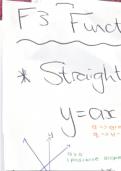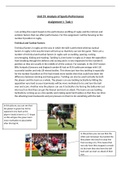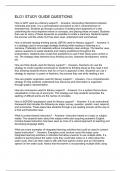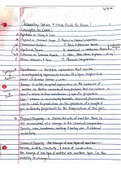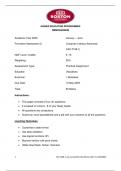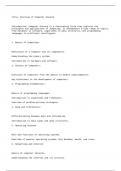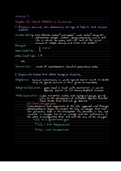Table of Contents
Introduction.......................................................................................................................2
Digestive system................................................................................................................2
Mouth..........................................................................................................................................2
Pharynx........................................................................................................................................2
Oesophagus..................................................................................................................................3
Stomach.......................................................................................................................................3
Small intestine..............................................................................................................................4
Duodenum......................................................................................................................................................4
Jejunum...........................................................................................................................................................4
Ileum...............................................................................................................................................................4
Large intestine..............................................................................................................................4
Rectum.........................................................................................................................................5
Anus.............................................................................................................................................5
Associating organs.............................................................................................................5
Pancreas.......................................................................................................................................5
Liver.............................................................................................................................................6
Gall bladder..................................................................................................................................6
Chemical digestion.............................................................................................................7
Digestive enzymes..............................................................................................................7
Protease.......................................................................................................................................7
Amylase........................................................................................................................................8
Lipase...........................................................................................................................................8
Hydrolysis.....................................................................................................................................9
Assimilation..................................................................................................................................9
Nutrient absorption...........................................................................................................9
Active transport...............................................................................................................11
Diffusion..........................................................................................................................11
Chemical tests..................................................................................................................11
Macronutrients................................................................................................................15
Micronutrients.................................................................................................................16
Deficiencies......................................................................................................................18
Treatments......................................................................................................................21
Vitamin B12 deficiency anaemia.................................................................................................21
1
,Ulcerative colitis...............................................................................................................22
Conclusion........................................................................................................................26
Bibliography.....................................................................................................................27
Introduction
The human digestive system will be the subject of this report.
The mouth, oesophagus, stomach, pancreas, liver, gallbladder, small intestine,
large intestine, and anus are among the organs of the digestive system.
Understanding how these organs work together to digest food is essential to
understanding digestion. Aside from inspecting the components, I'll evaluate any
disorders that affect the digestive system, whether externally or internally. I'll
also look into whether or not these disorders can be treated, if so, how they can
be treated.
Digestive system
The gastrointestinal tract, as well as the liver, pancreas,
and gallbladder, compose the digestive system. From the
mouth to the anus, the gastrointestinal tract is a
sequence of hollow organs connected by a long, twisting
tube. The mouth, oesophagus, stomach, small intestine,
large intestine, and anus are the hollow organs that make
up the gastrointestinal tract. The digestive system's solid
organs are the liver, pancreas, and gallbladder. These
organs can be seen in figure 1. Digestion is necessary
because your body requires nutrients from food and drink
in order to function correctly and stay healthy. Nutrients
include proteins, lipids, carbohydrates, vitamins,
minerals, and water. Nutrients are broken down into small enough pieces for
https://bit.ly/3DqImxE
your body to absorb and utilise for energy, growth, and cell repair.
Mouth
When you chew, the digestive process begins in your
mouth. During the oral phase of digestion, the hard
and soft palates create the roof of the mouth, and the
salivary glands pour their secretions into the mouth.
There are three pairs of main salivary glands: one
near the upper teeth called the sublingual glands,
another near the floor of the mouth called
the submandibular glands, and the third near the floor
of the mouth called the parotid glands. Saliva contains
two key enzymes, salivary amylase, and lipase, which
begin the digestion of carbohydrates and fats in the
mouth. Saliva is primarily made up of water, but it
also contains electrolytes, mucus, glycoproteins, and
https://bit.ly/3LuqYuL
antibacterial compounds. Teeth assist in food tearing,
biting, chewing, and grinding. They combine saliva and Figure 2 is
food to make a somewhat smooth bolus that can be showing us the
swallowed. anatomy of the
Pharynx
The pharynx is a five-inch tube that runs from our
nose to our windpipe. It's a hollow structure lined by
2
, wet tissue. A moist lining with a mucus-rich barrier permits us to breathe while
also allowing our food to pass safely through our channels without harming our
sensitive tissues. The muscular pharynx serves as the oesophageal entrance.
Peristalsis is controlled by the constrictive circular muscles of the pharynx's
outer layer. Ingested food and drink will be safely sent through the intestinal
tract by a sequence of contractions. The longitudinal muscles of the inner layer,
on the other hand, will broaden the pharynx laterally and elevate it upward,
allowing food and water to be swallowed.
Oesophagus
The bolus enters the thoracic cavity through the oesophagus, a long and
relatively narrow tube comprised of smooth muscle that runs through it. To keep
food and liquid from travelling down the throat, the epiglottis shuts. The uvula, a
little flap that helps keep liquid out of your nasal cavity, is another small flap. A
ring-shaped muscle termed the oesophagus sphincter sits at the opening of the
upper oesophagus. When food or liquid approaches the oesophagus sphincter, it
detects this. The sphincter relaxes or opens in response to the signal, allowing
food to pass through to your
oesophagus. It remains closed when
there is no food or drink visible. Once Figure 4:
inside the oesophagus, the food is https://bit.ly/3K4z1yk
pushed downward by waves of
muscle contractions. The food
reaches the lower oesophagus after
passing through the diaphragm.
Another ring-shaped muscle named
the lower oesophageal sphincter sits
at the opening of the lower
oesophagus. It detects the arrival
of food and drink, much like the Figure 4 is an image
upper oesophageal sphincter. It showing us the
relaxes, allowing food to travel to structure of the the stomach.
When there isn't any food or liquid oesophagus flowing in, it
closes to keep stomach acid and digestive juices
out of the oesophagus.
Stomach
The gastrointestinal tract widens at the stomach,
becoming a hollow sac-like structure made up of
three layers of smooth muscle. The muscles are
divided into three layers: longitudinal, diagonal,
and circular (this can be seen in figure 5). To
churn the meal and combine it with stomach
secretions, they contract in unison. The mucous
membranes of the stomach contain cells that
release hydrochloric acid and digesting enzymes.
Enzymes are released in an inactive condition
until they are activated by the organ's low pH. The
inner surface of the stomach forms rugae ridges
when it is empty or contracted. When the stomach
is inflated, these ridges become more apparent
near the pyloric end. Endocrine glands regulate digestion and are found
Figure 5: in the
https://bit.ly/3IZTdzM
stomach. Gastrin, histamine, and somatostatin are some of the hormones
generated by the stomach, which can either increase or hinder digestion.
3


